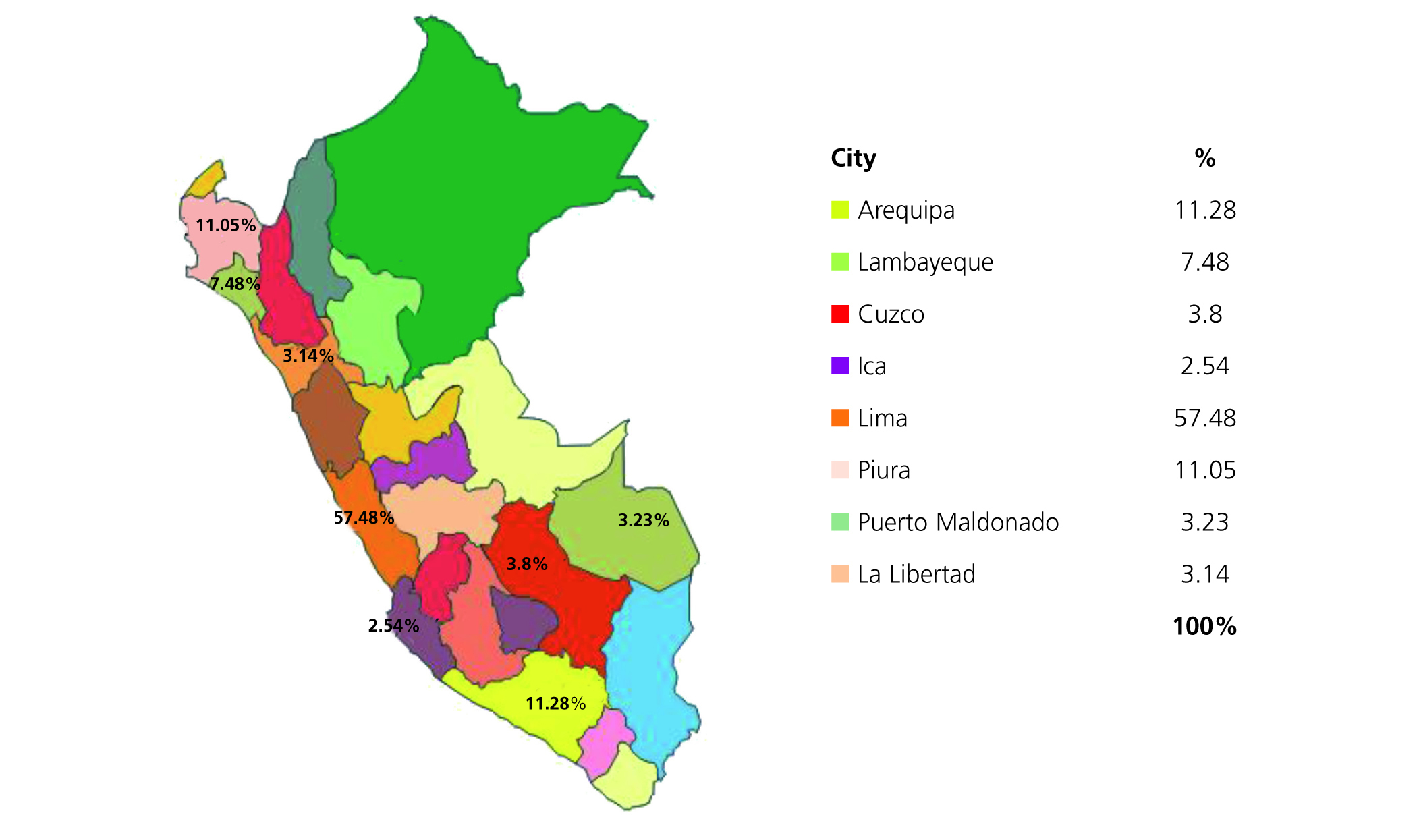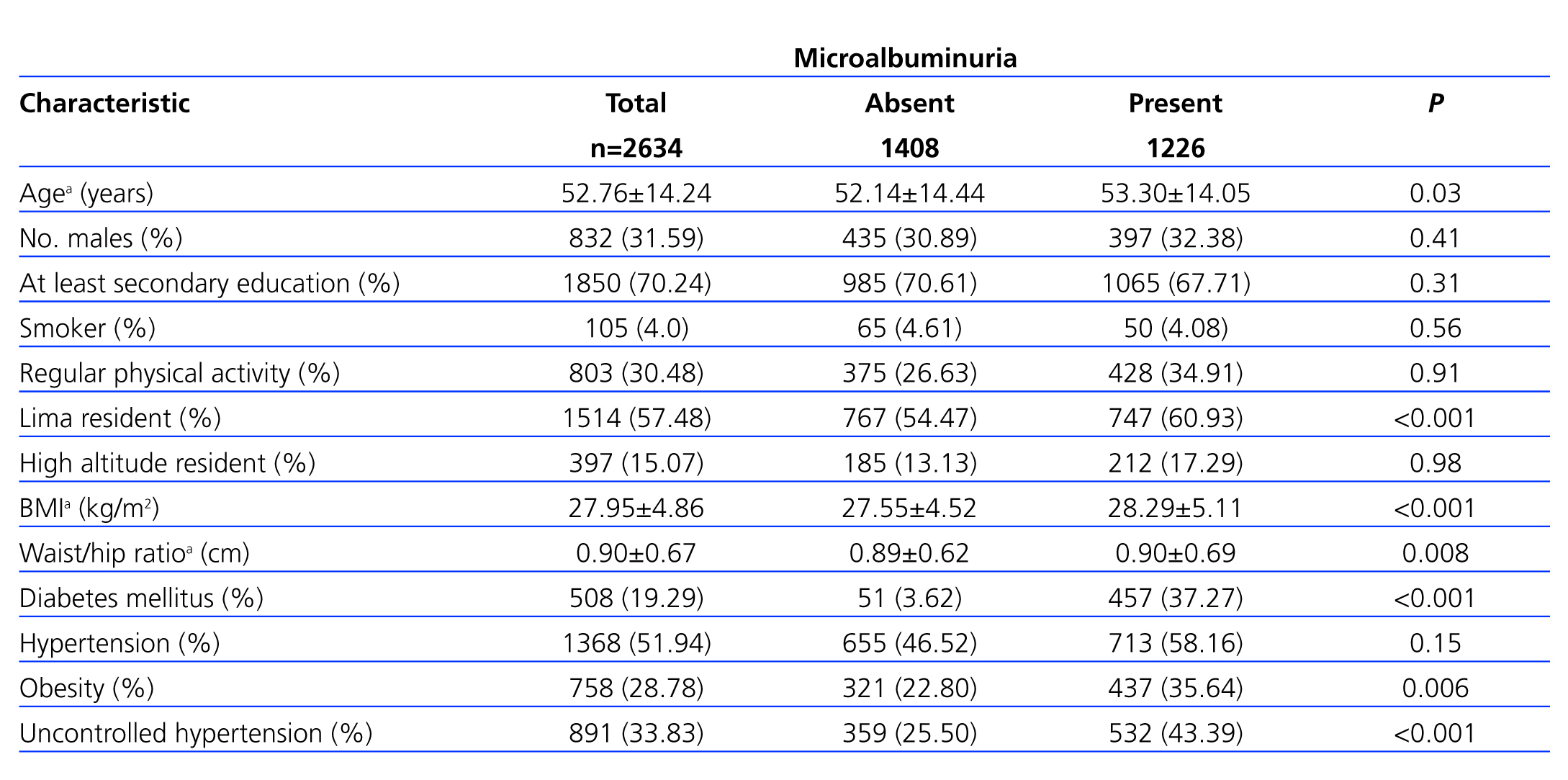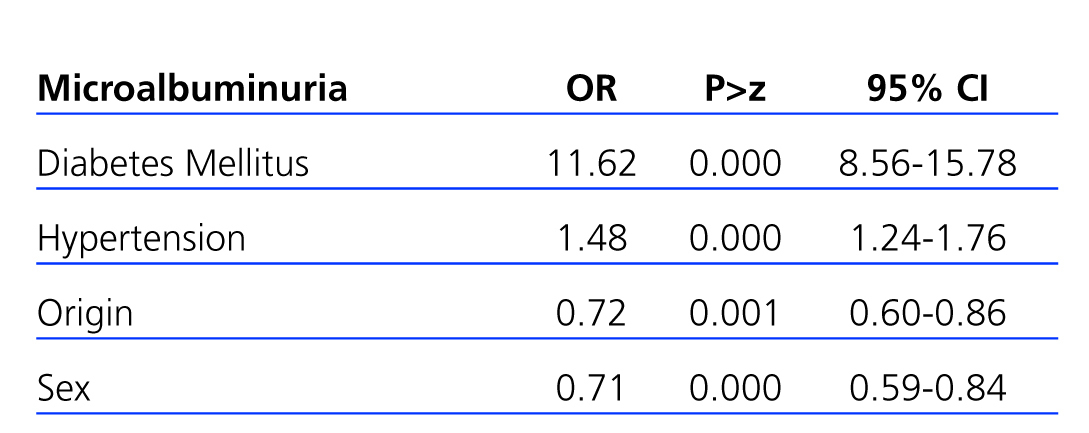Antecedentes: La enfermedad renal crónica es un problema de salud pública. Un diagnóstico precoz anticipa la posibilidad de daño vascular y sus complicaciones, y obliga a tomar medidas terapéuticas rápidas para impedir futuras complicaciones. Objetivo: Determinar la frecuencia de microalbuminuria (MAU) en pacientes ambulatorios sin control nefrológico con factores de riesgo conocidos y definir si hay un modelo de paciente en el cual el tamizaje se hace más eficiente. Métodos: Se realizó un estudio transversal en 2968 pacientes, en 23 centros hospitalarios de Perú. Fueron incluidos pacientes ambulatorios ≥ 18 años con diagnóstico previo de obesidad, hipertensión arterial (HTA) y/o diabetes mellitus (DM). En ellos se determinó el índice de masa corporal, el índice cintura cadera (IC/C), la presencia de MAU mediante tira reactiva y la presión arterial. Se determinó la fuerza de asociación (odds ratio [OR]) de estas variables con la presencia de MAU. Resultados: La edad media fue 52,76 ± 14,24 años. El 57,48% de la muestra provino de Lima y el 68,41% fueron mujeres. Hubo 508 (19,29%) que tenían diagnóstico de DM, 1368 (51,93%) HTA y 758 (28,78%) obesidad. La prevalencia general de MAU fue del 53,45%. El 8,96% tuvieron MAU > 100 mg/l. Hubo asociación significativa con DM (OR: 11,62, intervalo de confianza [IC]: 8,55-15,78) y con HTA mal controlada (OR: 1,48; IC: 1,24-1,76). Los captados en Lima (OR: 0,75; IC: 0,64-0,89) y las mujeres (OR: 0,72; IC: 10,60-0,86) mostraron asociación como factores protectores. Conclusión: La prevalencia de MAU en la población estudiada fue del 53,45%. El modelo de asociación más relevante fue tener DM y estar hipertenso durante la evaluación.
Chronic kidney disease (CKD) is a public health issue and is considered a common and harmful, but treatable disease. Early diagnosis can prevent the possibility of severe vascular damage and its complications, facilitating prompt and aggressive therapeutic measures. Objective: To determine the frequency of microalbuminuria (MAU) in outpatients with known risk factors and to analyse whether a patient model exists in which screening is more efficient. Methods: Ours was an observational, cross-sectional study involving 2968 patients from 23 nephrology centres in Peru. Inclusion criteria were: male and female outpatients aged ≥18 years with previous diagnosis of hypertension (AHT), diabetes mellitus (DM) and/or obesity. We obtained values for body mass index (BMI), waist hip ratio (WHR), blood pressure, and microalbuminuria by dipstick. We then tested for the association of these variables with MAU using odds ratios (OR). Results: The mean age of our patients was 52.76±14.24 years, 68.41% were women, and 57.48% of the patients came from the capital. DM was diagnosed in 508 patients (19.29%), 1368 (51.93%) had hypertension, and 758 (28.78%) were obese. The frequency of MAU was 53.45%, and 8.96% of patients had MAU>100 mg/L. There was a highly significant correlation with DM (OR: 11.62; 95% CI: 8.55-15.78) and AHT (OR: 1.48; 95% CI: 1.24-1.76), while being from the capital (OR: 0.75; 95% CI: 0.64-0.89) and female sex (OR: 0.72; 95% CI: 10.60-0.86) acted as protective factors. Conclusions: The frequency of microalbuminuria in the population studied was 53.45%. There was a highly significant correlation with diabetes and a hypertension found during evaluation, while being from the capital and female sex acted as protective factors.
INTRODUCTION AND OBJECTIVES
Chronic kidney disease (CKD) is a public health issue and is considered a common and harmful, but treatable disease. Studies have shown that its global prevalence is high, around 10%-16%,1,2 and that the incidence for this condition has increased dramatically in the last decade, with severe impacts on health economy.3,4
The prevalence of CKD patients that need dialysis treatment (terminal CKD) is approximately 337 patients per million population (pmp) in the United States,1 126pmp in Europe,4,5 and about 268pmp in Peru, considering the general population.6
The primary causes of CKD are diabetes mellitus (DM), hypertension (AHT), and primary glomerular diseases.4,5 These three conditions are the causes of CKD in approximately 50% of all patients currently on chronic renal replacement therapy,7,8 and proteinuria is an early or late marker for the three of them.8,9
Evidence suggests that certain treatments can prevent or at least delay complications, slow progression, and reduce the risk of cardiovascular disease in CKD patients.10 In this sense, an evaluation of proteinuria plays an important role in the diagnosis so as to evaluate the prognosis of the disease and monitor therapeutic interventions.8,11 Indeed, early screening for microalbuminuria (MAU) has been defined as one of the best methods for modifying the natural course of the diseases that cause CKD.
The concept of MAU was introduced in 198212 as an early biological marker for diabetic nephropathy. It was later extended as a factor for cardiovascular risk, mortality in the general population, endothelial dysfunction, and systemic vascular disorders in AHT.13
In the treatment of CKD, our greatest interest is to reduce incidence rates, so it is necessary to emphasise early detection of renal damage in those diseases most commonly responsible for leading to CKD: DM, AHT, and glomerulopathies.14 In 1968, Wilson and Jungner defined the necessary criteria for a productive CKD prevention and screening programme.15 They focused on those highly prevalent diseases that have an important impact on the patient, are long-term asymptomatic, preventable, easily detected, and, above all, where the cost of detecting and preventing the disease has been shown to be lower than the cost of treating it. In later years, these criteria have been supplemented with cardiovascular disease, family history of CKD, and obesity.
Many of these concepts have been thoroughly examined in developed countries. However, the specific influence of certain prevalent diseases in the population of developing countries is still not well defined, and so these same diseases may have a varying impact according to the composition of specific populations, including variables such as age, race, and environment.
With this in mind, our study aimed to determine the frequency of MAU in patients with established risk factors, such as DM, AHT, and obesity, who sought treatment at nephrology departments throughout Peru on the 2010 World Kidney Day, establishing a patient model with a more efficient screening protocol.
MATERIAL AND METHOD
Ours was a descriptive, cross-sectional study involving voluntary outpatients of both sexes, older than 18 years, with known risk factors for CKD (AHT, DM, and obesity). They came during the CKD screening campaign on the 2010 World Kidney Day, and had not previously visited a nephrologist. This campaign was organised six months in advance by the Peruvian Society of Nephrology, in coordination with the nephrology departments of the different hospitals throughout the country. Each nephrology department was provided with the necessary materials for the campaign. The programme was nation-wide, and was advertised using all major media: radio, television, and written media, sending a message of the basic concepts of kidney disease and inviting the population with known risk factors to seek care at the campaign sites.
We used a standard information form to collect demographic variables (sex, age, origin, and level of education), personal health history (DM, AHT), and details on lifestyle (physical activity, tobacco use, and alcohol use). Each patient underwent a clinical evaluation, including blood pressure, height, weight, body mass index (BMI), and waist/hip ratio (WHR).
Based on the result of the evaluation, each patient received dietary and medical advice. Patients with positive results for MAU were referred to the relevant nephrology department for evaluation and monitoring.
MAU was determined using Micral Test II® dipsticks (Boehringer Mannheim), based on a specific immunocapture method in which a colour reaction is mediated by an enzyme conjugated to antibodies. Following the manufacturer’s instructions on taking samples and interpreting results, which are solely qualitative, we considered the result to be positive for MAU when the dipstick revealed a value ≥20mg/l (1+, 2+, or 3+), based on the colour scale provided by the manufacturer.
Patients were considered to be overweight if their BMI was ≥25 and obese if ≥30. WHR between 0.78 and 0.94 was considered normal in males and between 0.71 and 0.85 for women.
We performed a descriptive analysis examining the distribution of frequencies for each variable studied, expressed as mean and standard deviation for continuous variables and proportions for categorical variables.
Considering MAU as a dependent variable, we calculated odds ratios (OR) and 95% confidence intervals (95% CI) for all qualitative categorical variables, and used Student’s t-tests for continuous variables. We then performed a multivariate analysis to define a model that was significantly correlated with MAU in our study population. We used STATA statistical software, version 9.9, for all analyses.
RESULTS
A total of 2968 patients were evaluated. Some 334 of them (11.25%) had no background of chronic disease and were excluded from the final evaluation, leaving 2634 patients for our study population, with a mean age of 52.76±14.24 years (range: 18-95 years). The population was primarily made up of women (68.41%). The health campaign took place in 23 hospitals throughout Peru: 11 in the capital city (Lima) and 12 in other cities (Figure 1). Lima was the city of origin for 57.48% of the patients, and the other 42.52% were from the rest of the country. The city of origin was higher than 1500 metres above sea level for 397 subjects (15.1%).
By level of education, 950 subjects (35.46%) had a higher education, 916 (34.78%) had a secondary education, 634 (24.07%) had a primary education, and 150 (5.69%) were illiterate.
Some 1368 (51.93%) patients reported AHT, 758 (28.78%) were obese, and 508 (19.29%) had DM. Tobacco use was reported in 105 subjects (4%), whereas alcohol consumption at least once per week was reported in 277 (10.5%), and only 803 (30.48%) had regular physical activity.
The mean weight of the study subjects was 68.11±13.23kg (range: 34-137.5kg), and the mean BMI was 27.95±4.86kg/m2 (range: 15.76-56.39kg/m2). Mean WHR was 0.90±0.07cm (range: 0.62-1.47cm).
MAU was observed in 1408 subjects (53.45%), and 9.3% of patients had an MAU>100mg/l.
The association of MAU with pathological histories is summarised in Table 1. This condition was observed in 89.96% of diabetics (457/508), 52.12% of hypertensive patients (713/1368), 57.65% of obese patients (437/758), 28.42% of smokers (27/95), and 18.77% of alcohol consumers (52/277). In the case of patients with two different pathologies, 69.4% (422/608) had MAU.
Upon performing a multivariate logistic regression, we found that the patient profile with the most efficient screening results was a history of DM and the finding of uncontrolled AHT during the evaluation. Living in the capital (Lima) and female sex were protective factors against MAU. On the contrary, DM was the most important predictive factor for the presence of MAU (OR: 11.62; 95% CI: 8.55-15.78) (Table 2).
DISCUSSION
Similar to the situation in other countries, CKD in Peru has experienced an exponential increase in recent years in association with several factors, including increased survival, higher prevalence of chronic diseases, and especially a lack of promotion and prevention measures for renal health.
This study was a collaborative effort made by all nephrologists in Peru, with the goal of procuring national reference data and reinforcing health prevention strategies.
We found that the frequency of MAU in diabetics (89.9%) was higher than values previously reported.
The prevalence of MAU in patients with DM varied according to race, with higher rates in Asians and Latin Americans than in Caucasians.19,20 The magnitude of this difference was also reported in an international study involving 24 000 patients with DM and no known albuminuria.20 The mean duration of DM was almost 8 years, and the rate of MAU was significantly higher in Asians and Latin Americans (43%) than in Caucasians (33%). Similar results have been found by other studies performed in Latin America, especially in Mexico. Cerón Sánchez et al21 reported 67.3% of patients with MAU in a population in Tamaulipas (Mexico) using the albumin/creatinine ratio; Olaguer et al22 observed MAU in 85.3% of 24-hour urine samples from patients at the Coahuila public hospital; Gonzales Villalpando et al23 observed MAU in 54.7% of subjects in Mexico City, and Cueto Manzano et al found early nephropathy (MAU with a normal or slightly reduced glomerular filtration rate) in 40% of Mexican patients.24 These values differ greatly from those observed in European populations, in which MAU is found in approximately 30% of subjects.25-27
The value of MAU observed in hypertensive patients is only comparable to the results from Habbal et al28 (67.8%) in a cross-sectional study involving 457 hypertensive subjects in Morocco.
As regards altitude, some reports have observed MAU in populations that live between 3200 and 4000 metres above sea level and with polycythaemia and/or hyperuricemia.29,30 In our study we did not evaluate people in high altitude.
The high proportion of MAU observed in our study may be due to the fact that ours was a health campaign that did not involve a stratification of patients based on the duration of disease, which is extremely important and involves a greater severity, especially in DM. Furthermore, the data were collected in hospital settings and the campaign may have attracted more complex subjects and, lastly, the use of dipsticks for measuring MAU involves some limitations such as false positives/negatives depending on the dilution or alkalinisation of urine samples. Although the majority of clinical practice guidelines advise against using dipsticks in screening programmes to detect proteinuria and MAU, those that do include this methodology recommend confirming the diagnosis using a quantitative method.31,32
However, in countries where the prevalence of CKD is not well known and screening campaigns such as ours have been implemented, this technique has been used for screening in order to cut costs and widen the coverage and information provided regarding this disease.29,33 Despite its limitations for diagnosing kidney disease, we used this technique since not all participating nephrology departments had the capability to measure proteinuria/creatinine or albumin/creatinine ratios. All patients with positive MAU results were referred to their corresponding nephrology departments in order to definitively rule out the presence of CKD.
In light of our results, it is important to plan future studies that involve the measurement of renal function, which would allow for the detection of kidney disease as well as referring these patients to the relevant health centres. Additionally, we must emphasise programmes for the prevention and control of chronic diseases (DM and AHT) and reinforce renal health programmes in order to provide better care and reduce the morbidity and mortality rates associated with kidney disease.
In conclusion, our study found an incidence of MAU of 53.45%, and the most efficient screening model for kidney disease is a subject with DM that is diagnosed with uncontrolled AHT in the patient examination. Living in Lima and female sex acted as protective factors against this condition.
Conflicts of Interest
The authors affirm that they have no conflicts of interest related to the content of this article.
Acknowledgements
We would like to thank all multi-disciplinary teams from all hospitals that collaborated in the 2010 World Kidney Day campaign in Peru.
Figure 1. Distribution by patient origin
Table 1. General characteristics
Table 2. Multivariate analysis












